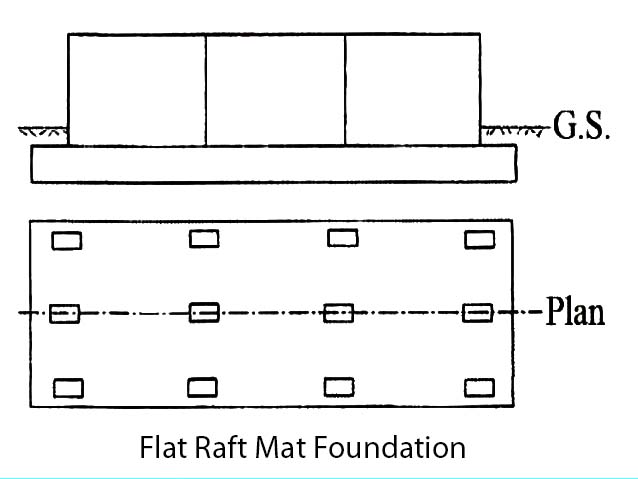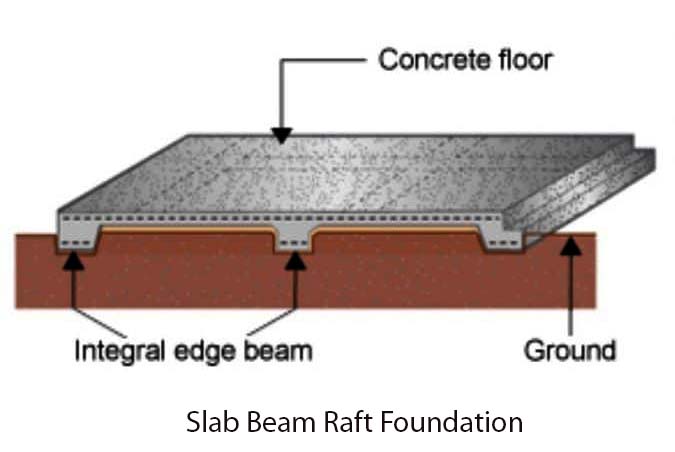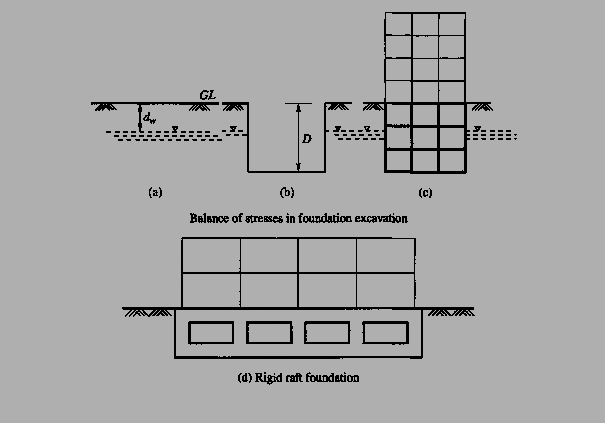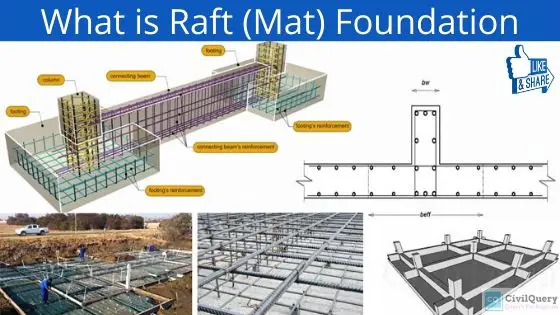What is the Raft Foundation?
Raft foundation is the Essentially continuous slab, which is resting on the hard soil, which extends over the entire building footprint. It declines the contact pressure in comparison with conventional strip or trench footing. Raft foundation is also known as a Mat foundation.
Mat foundation is a suitable solution for the construction of the building where the soil bearing capacity is very low, as it transfers the weight of the building over the entire footprint of the building. Raft foundation also reduces the stress on the soil.
The Idea of stress is very basic to Civil Engineering. Stress is simply calculated as “Total Weight of Building divided by Area of Building.
For Example; if building measures 10 X 10 and weighs 200 ton, and it has a raft foundation. Then the stress on soil is Weight / Area = 200 / 1000 Total Stress on Soil = 2 tons per M2. If the same building is supported by 6 individual footings, each size of 1 M X 1 M Therfore, Total Area of Footing is 6 M2 Wight of the building 200 Ton Calculate the Stress on Soil = Weight / Area = 200 / 6 Total Stress on Soil = 33.33 tons per M2 Therefor, increasing total area of foundation can drastically reduces the stress on soil.
Raft Foundation Presentation (PPT)
When to use Raft or Mat Foundation in Construction
For building foundation design, it is one of the most important aspects is to choose the right Foundation.
Here is the list of some of the major aspects, when to use or choose a Mat foundation.
- When the soil has a low bearing capacity.
- Where the load of the structure has to be distributed over the large surface area.
- When an individual or any other foundation area would be covered approximately more than 50% of the total ground area below the structure.
- When the columns and the Shear walls are placed so closely, where the individual footings overlap each other.
- Where the stress on the soil needs to be reduced.
- The basement is to be constructed.
Different Types of Raft Foundation
There are several different types of a raft is used in Construction, depending upon its condition of the soil and the load imposed on the foundation.
- Solid Slab Raft Foundation
- Slab Beam Raft Foundation
- Piled Raft foundation
- Cellular Raft Foundation
- Balancing or Floating raft foundation
Solid Slab
Solid slab Raft foundation can be further divided into 4 different Foundation
- Flat Raft mat foundation
- Wide toe rafts
- Blanket rafts
- Slip plan rafts
Flat Raft Mat Foundation

Typically, this type of Raft is used, where the position of the column is a regular over the entire footprint of the building, it uses to provide the equal stress distribution on the foundation.
In this type foundation Steel mess typically used at the bottom layer (where the column foundation connection is close) and at the top of the Concrete mat (Midspan between column), to provide resistance in both the direction.
Wide toe Raft
A wide toe raft is utilized when the ground conditions imply that to give the essential burden support, a level raft solid chunk would need to be amazingly thick, which would make it over the top expensive. Rather, the section is shaped with a more profound strengthened ‘toe’ which stretches out to help the outer side of a pit divider.
Blanket raft
Where the construction site includes the small area of weaker soil or other soil types, a blanket raft may provide the best solution. Here in this type of raft, a stone Blanket is laid on the soil in a layer. Lay stone blanket up to the required level, before pouring concrete raft. The stone blanket and Raft foundation work together to provide even load support, despite an area of weakness within the footprint of the building.
Slip Plan Raft
Slip Plan Rafts Comes with a preliminary layer of sand, which is laid over the little large surface area then the required raft foundation, Where the gap around the raft filled with the compressible filling material.
Slab Beam

This type of raft commonly used in a building, which involves column loads that are not evenly distributed over the footprint of the entire building. The reinforcement of the column is sited on the top of the reinforced ground beam, and this provides necessary load-bearing capacity.
Cellular

This type of Mat foundation comes with two concrete slabs, which lock together with the ground beam. The cellular raft is usually rigid, and so they are most suitable for the ground which is likely to settle unevenly, or where a very heavy load is anticipated. This type of Mat foundation is used where the soil settlement is uneven.
Read Also: What is Shallow Foundation?
Piled

In this type of Mat Foundation, Raft is supported by piles in soil. This type of foundation is used where the soil of high compressibility and high-water table. This type of foundation is well suitable for high rise buildings or structures.
The piles are used to reduce the settlement of soil, and it increases the load-bearing capacity of the soil.
Balancing or Floating

Balancing or Floating Raft are commonly used, where the reduction of the soil settlement is of absolute importance. Moreover, where the soil bearing capacity is extremely low. This raft foundation created through the excavation of the soil in such a way that the weight of the excavated soil balances the entire structure and foundation.
Read Also: Types of Deep Foundation and its Uses in Construction
This type of foundation might not be cost-effective as it has a significant amount of excavation work, as well as a work related to the construction of the retaining structures prior and during the excavation work, to reach the depth till the required foundation
Advantages of the Raft Foundation
The Advantages of the Raft foundation are listed below.
- It is suitable for the construction, where the soil bearing capacity is low.
- It helps to distribute the load of the building structure over the entire area of the building footprint.
- The Raft foundation is constructed for shallow depth. However, it requires less excavation work.
- It reduces the settlement of the soil.
Disadvantages of the Raft Foundation
The Disadvantages of the Raft Foundation are listed below.
- In the Raft foundation, a very large amount of reinforcement is required, which increases the cost of the entire project.
- It requires more attention or supervision on a raft foundation in case of concentrated loads.
- If the raft not treated properly, there is a very high chance of the edge corrosion.
- Skilled laborers required for the construction of the raft foundation.
Source of this article is from Heaton Manufacturing

